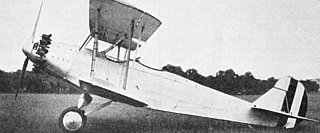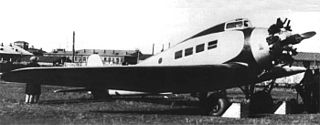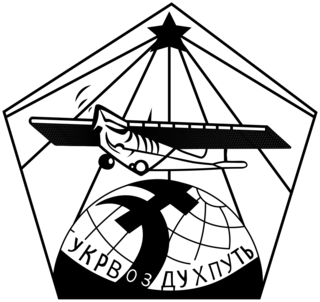
The Kharkiv KhAI-5, was a Soviet reconnaissance and light bomber aircraft, designed in the mid-1930s in the Kharkiv Aviation Institute, under the direction of Iosif Grigorevich Nyeman.

The Northrop C-19 Alpha was a series of three aircraft purchased from Northrop by the US Army Air Corps in 1931. They were slightly modified versions of the civil Northrop Alpha Type 2.

The Dornier Do 22 was a German seaplane, developed in the 1930s. Despite good performance, it was built only in small numbers and entirely for the export market. The type was operated in the Second World War by Finland, Greece and Yugoslavia.

The Tupolev ANT-14 Pravda was a Soviet aircraft, which served as the flagship of the Soviet propaganda squadron. It has been credited as Russia's first all-metal aircraft, with a corrosion-resistant-steel structure.

The de Havilland DH.34 was a single engined British biplane airliner built by the de Havilland Aircraft Company in the 1920s. 12 were built, with the DH.34 serving with Imperial Airways and its predecessors for several years.

The Fokker F.25 Promotor, first flown in 1946, was a single-engined, twin-boomed, four-seat passenger monoplane with a pusher engine mounted at the rear of a central nacelle. It was of wooden construction and has fitted with a retractable nosewheel undercarriage. One feature of the design was that instead of a 2 + 2 seating, the pilot sat in front to the left, and all three passengers were on a bench seat to the rear of him. Alternatively, when being used as an air ambulance aircraft, it could carry a patient on a stretcher, which was loaded through a hatch in the aircraft's nose. The F.25 was evocative of the pre-war G.I design.
The Tupolev MTB-1 was a patrol flying boat built in the Soviet Union in the mid-1930s. It was a refined version of the unsuccessful Chyetverikov MDR-3. The revised design retained the MDR-3's hull, but added a newly designed, full-cantilever wing, a new tail, and a new engine installation featuring two tractor and one pusher unit. Trials began in March 1934 but the prototype was destroyed during one takeoff.

The Dornier Komet (Comet), Merkur (Mercury), Do C, Do D, and Do T were a family of aircraft manufactured in Germany during the 1920s, originally as small airliners, but which saw military use as well. The earliest aircraft in the series were basically landplane versions of the Delphin flying boat, and although the Delphin and Komet/Merkur series diverged from each other, design changes and refinements from one family were often incorporated into the other. All variants were braced high-winged single-engine monoplanes with conventional landing gear.

The Aleksandrov-Kalinin AK-1 was a prototype airliner built in the Soviet Union in the early 1920s, designed as part of a project by TsAGI to investigate low-cost construction techniques and to verify calculation models for thick-section airfoils. It was a high-wing, strut-braced monoplane of conventional design, powered by a single engine in the nose. Two passengers could be carried in an enclosed cabin in the fuselage, while a separate enclosed cockpit was provided for the pilot, plus a co-pilot or an additional passenger. Construction was wooden throughout.

The Kalinin K-5 was an airliner produced in the Soviet Union in the 1930s, built in larger quantities than any other Soviet airliner of its time, with some 260 aircraft constructed. It was a conventional, high-wing, strut-braced monoplane with a fully enclosed cabin and cockpit, and followed the general pattern developed by Kalinin in his earlier designs, though on a larger scale.

The Keystone K-55 Pronto was a mail plane developed in the United States in the late 1920s.

The Kharkiv KhAI-1 (ХАІ-1) was an airliner produced in the Soviet Union in the early 1930s, unusual in that it was designed by students. An exceptionally clean design, the KhAI-1 was the first European passenger transport aircraft to feature retractable undercarriage, and boasted a top speed better than the fighter aircraft in service at the time. Some 40 KhAI-1s were operated by Aeroflot, but while a dedicated military version, the KhAI-1VV was developed and flown in prototype form, this did not enter production.

The Kalinin K-7 was a heavy experimental aircraft designed and tested in the Soviet Union in the early 1930s. It was of unusual configuration, with twin booms and large underwing pods housing fixed landing gear and machine gun turrets. In the passenger version, seats were arranged inside the 2.3-meter thick wings. The airframe was welded from KhMA chrome-molybdenum steel. The original design called for six engines in the wing leading edge, but when the projected loaded weight was exceeded, two more engines were added to the trailing edges of the wing, one right and one left of the central passenger pod. Nemecek states in his book that at first only one further pusher engine was added.

Ukrpovitroshliakh was an airline based in Kharkiv, Ukrainian SSR during the interbellum. It operated scheduled domestic (USSR) services. It was the first civil aviation company of Ukraine.

The Zeppelin-Lindau Rs.IV was a Riesenflugzeug monoplane all metal flying boat with a stressed skin hull and fuselage developed for the Imperial German Navy to perform long range patrols over the North Sea. It had been developed by Claudius Dornier while working for Zeppelin in the town of Lindau.
The Yakovlev Ya-19,, was a 5-seat light transport aircraft developed directly from the Yakovlev UT-3 during the late 1930s. The Ya-19 did not enter production, despite positive results from flight trials, due to the lack of development of the UT-3 and cancellation of the Voronezh MV-6 engine program, which were the result of changing priorities in the face of the Great Patriotic War.

The Kalinin K-1, also known as RVZ-6, was a Soviet passenger plane that could carry three people.
The Kalinin K-2 was a Soviet airliner designed and built by the designer Konstantin Kalinin. The aircraft was a variant of the predecessor K-1 with a stronger engine and an all-metal construction. The total weight of the construction exceeded that of the planning considerably. The first flight took place in 1926. The assembly was more complex than the K-1, but only four were built.
The Grigorovich MUR-1,, was a trainer flying boat built in the Soviet Union in the mid-1920s.

The Kalinin K-12 was a proof-of-concept aircraft developed by the Kalinin Design Bureau in the 1930s.
















